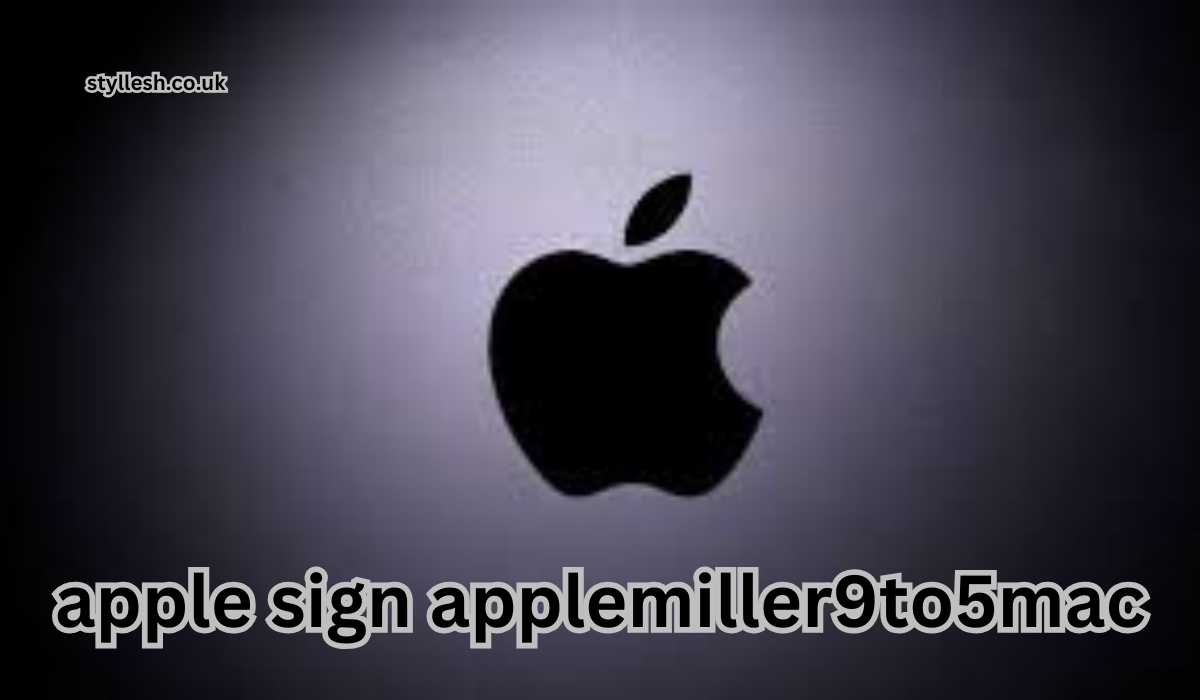Explore the innovative apple sign applemiller9to5mac, enhancing security and convenience in authentication. Discover its benefits, applications, and future in the tech landscape.
Table of Contents
ToggleIntroduction
In an ever-evolving technological landscape, Apple continues to lead the charge with innovations that prioritize user experience and security. Recently, the introduction of the “Apple Sign” feature, as detailed by Applemiller from 9to5Mac, has captured significant attention in the tech community. This feature is not just a simple update; rather, it represents a major step forward in how users interact with their devices and applications, making authentication faster, more secure, and far more convenient than ever before. In this blog post, we will delve deep into the specifics of the Apple Sign feature, exploring its functionalities, potential applications, and how it aligns with Apple’s mission to enhance user security while providing a seamless experience. Through this exploration, we aim to uncover the multifaceted nature of Apple Sign and its implications for both consumers and developers alike.
What is Apple Sign?
The concept of Apple Sign revolves around creating a more efficient authentication process for users interacting with various applications and services on Apple devices. This innovative feature leverages advanced biometric technology, specifically Face ID and Touch ID, to facilitate a seamless sign-in experience. Essentially, Apple Sign replaces the traditional password input method with a quick biometric verification process, allowing users to access their accounts with a simple facial scan or fingerprint. This significant shift not only enhances user convenience but also fundamentally alters how we perceive digital security. With Apple Sign, gone are the days of struggling to remember complex passwords or worrying about their safety; instead, users can confidently engage with their devices, knowing that their identities are protected by cutting-edge technology.
The Mechanism Behind Apple Sign
To fully appreciate the impact of Apple Sign, it’s essential to understand the technology that underpins it. Apple Sign operates on a sophisticated framework of encryption and biometric verification that ensures user data remains secure while allowing for rapid access. When users opt to utilize Apple Sign, they engage in a two-step process. First, they authenticate their identity through either Face ID or Touch ID, both of which utilize advanced sensors and algorithms to verify that the individual attempting to sign in is indeed the account holder. Once authenticated, Apple generates a unique cryptographic token that serves as proof of identity. This token is transmitted to the application or service, allowing for instantaneous access without the need for a password. The use of such cryptographic tokens significantly reduces the risk of unauthorized access and hacking attempts, reinforcing the overall security of user accounts across the board.
The Benefits of Apple Sign for Users
When considering the advantages of Apple Sign, it’s essential to focus on both security and convenience. Users benefit from an enhanced security posture, as biometric authentication is inherently more secure than traditional passwords, which can be easily guessed, stolen, or forgotten. Additionally, Apple Sign greatly improves the user experience by streamlining the login process. Imagine not having to fumble around for a password, especially in high-stakes situations such as online banking or shopping. Instead, users can access their accounts within seconds using their unique biometrics, making the entire experience feel more intuitive and user-friendly. Furthermore, Apple Sign is designed to work across various applications, ensuring that users can enjoy this seamless experience regardless of the platform or service they are accessing. As a result, the introduction of Apple Sign marks a significant milestone in creating a unified and secure digital environment for Apple users.
How Apple Sign Enhances Security
The introduction of Apple Sign is a game changer in the realm of digital security, and it deserves a closer examination. Traditional passwords have long been a weak link in the security chain, making accounts vulnerable to a myriad of attacks, including phishing and credential stuffing. With Apple Sign, Apple has effectively removed this vulnerability by eliminating the need for passwords altogether. Instead, the use of biometric data ensures that only the legitimate user can access their accounts. Biometric authentication methods, such as facial recognition and fingerprint scanning, are unique to each individual, making them far less susceptible to fraud. Furthermore, Apple Sign employs state-of-the-art encryption techniques to protect the cryptographic tokens generated during the authentication process. This means that even if data is intercepted during transmission, it remains encrypted and useless to unauthorized users. Overall, Apple Sign represents a paradigm shift in how digital security is approached, making it an invaluable addition to Apple’s suite of user protection features.
Potential Applications of Apple Sign
The versatility of Apple Sign opens up a wealth of potential applications across various sectors, significantly enhancing user experiences in numerous contexts. One of the most promising areas for implementation is e-commerce. Imagine a world where consumers can shop online without needing to remember or input a password. With Apple Sign, users can make purchases with just a glance or a touch, dramatically speeding up the checkout process and reducing cart abandonment rates. Additionally, Apple Sign can have a profound impact on banking and financial services. Security is paramount in this industry, and the ability to log in securely and quickly using biometric authentication can build greater trust between consumers and financial institutions. Customers can manage their finances with confidence, knowing their sensitive information is protected. Social media platforms can also benefit from Apple Sign, as users would enjoy a streamlined login process, encouraging them to engage more frequently with their networks. Overall, the potential applications of Apple Sign are vast and varied, offering significant improvements to user experiences across multiple sectors.

How Developers Can Leverage Apple Sign
As Apple Sign gains traction among users, developers have a unique opportunity to integrate this feature into their applications and services. By implementing Apple Sign, developers can enhance the security and usability of their offerings, attracting more users and fostering greater loyalty. The integration process is straightforward, allowing developers to utilize Apple’s APIs to incorporate Apple Sign into their applications seamlessly. Additionally, by adopting Apple Sign, developers can position themselves at the forefront of security innovations, ensuring that their applications remain competitive in an increasingly security-conscious market. Furthermore, Apple’s commitment to maintaining high standards for user privacy and data protection means that developers can rely on the robust security measures associated with Apple Sign, reducing the burden of having to create their own authentication systems. By leveraging Apple Sign, developers can not only enhance their applications but also contribute to a more secure digital landscape.
The Role of Privacy in Apple Sign
While security is a significant focus of Apple Sign, privacy is equally paramount. Apple has long been a proponent of user privacy, and this principle is deeply embedded in the design of Apple Sign. The biometric data used for authentication never leaves the device; it is stored securely within the device’s secure enclave. This means that even Apple does not have access to users’ biometric data, ensuring that personal information remains confidential. Additionally, the cryptographic tokens generated during the authentication process are temporary and unique to each session, further safeguarding user data. Apple Sign is built with user privacy in mind, providing a level of confidence that is increasingly rare in today’s digital landscape. As users become more aware of the importance of protecting their personal information, Apple Sign serves as a reassuring reminder that their data is treated with the utmost respect and security.
The Future of Apple Sign
Looking ahead, the future of Apple Sign appears bright and full of potential. As more users embrace this innovative authentication method, we can anticipate further advancements and enhancements to the feature. Apple is continuously evolving its technology, and it is likely that future iterations of Apple Sign will incorporate even more sophisticated security measures, potentially expanding beyond biometric authentication to include additional layers of verification, such as behavioral biometrics or geolocation. Moreover, as the demand for seamless, secure digital experiences grows, we can expect Apple Sign to become a standard feature across a wide range of applications and devices. This evolution will not only benefit users but also developers, who will have the opportunity to create new and exciting experiences that leverage the capabilities of Apple Sign. Ultimately, the future of Apple Sign aligns with Apple’s overarching mission to innovate while prioritizing user experience and security.
How Apple Sign Reflects Apple’s Brand Values
The introduction of Apple Sign is a clear reflection of Apple’s brand values, which emphasize innovation, user-centric design, and a commitment to privacy and security. From the outset, Apple has positioned itself as a leader in technology that not only enhances the user experience but also respects user privacy. The development of Apple Sign exemplifies this philosophy by providing users with a powerful tool that simplifies authentication while maintaining a strong focus on security. Furthermore, Apple’s commitment to user experience is evident in the intuitive design of Apple Sign, which allows users to access their accounts quickly and effortlessly. By aligning its products and services with these core values, Apple continues to build trust and loyalty among its user base, solidifying its position as a leader in the tech industry.
User Adoption and Reception of Apple Sign
As Apple Sign begins to roll out across various devices and applications, user adoption and reception will play a crucial role in determining its success. Early indications suggest that users are excited about the prospect of a more secure and convenient authentication process. With increasing concerns about password security and data breaches, Apple Sign offers a refreshing alternative that resonates with users’ desire for improved security measures. Furthermore, the seamless integration of Apple Sign into existing applications will be critical in fostering user adoption. Developers who prioritize the implementation of Apple Sign can position their apps as modern and secure, attracting a user base that values convenience and security. As users embrace Apple Sign, its reputation as a transformative feature will likely grow, leading to widespread acceptance and integration into everyday digital interactions.

Challenges and Considerations for Apple Sign
While Apple Sign presents numerous advantages, it is essential to acknowledge the challenges and considerations associated with its implementation. One potential concern is the reliance on biometric data, which, although secure, may raise privacy concerns among users. Educating users about how their data is protected will be vital in addressing these concerns and building trust. Additionally, developers must ensure that their applications are designed to accommodate users who may prefer traditional authentication methods, providing options for those who may be uncomfortable with biometric verification. Furthermore, as with any technological innovation, there is always the potential for security vulnerabilities to emerge. Apple must remain vigilant in monitoring and updating Apple Sign to address any potential threats to user security. By proactively addressing these challenges, Apple can ensure that Apple Sign remains a trusted and effective authentication solution.
The Competitive Landscape of Authentication Solutions
As Apple Sign gains traction, it is essential to consider the competitive landscape of authentication solutions. Various companies are continually exploring innovative ways to enhance security and user experience, making it imperative for Apple to remain at the forefront of these developments. Passwordless authentication solutions are becoming increasingly popular, with many companies recognizing the limitations of traditional passwords. Apple Sign stands out in this crowded field due to its integration with existing Apple services and its focus on user privacy. To maintain its competitive edge, Apple must continue to innovate and refine Apple Sign, ensuring that it not only meets user expectations but also sets the standard for security in the digital age. By doing so, Apple can solidify its position as a leader in authentication solutions and continue to provide users with unparalleled security and convenience.
Conclusion
The introduction of Apple Sign marks a significant milestone in the evolution of authentication technology. By prioritizing user experience and security, Apple has created a feature that simplifies the login process while enhancing data protection. With its advanced biometric capabilities, seamless integration, and commitment to privacy, Apple Sign offers a promising solution to the challenges associated with traditional authentication methods. As users and developers alike embrace this innovation, we can anticipate a future where secure, password-free access becomes the norm. Ultimately, Apple Sign exemplifies Apple’s dedication to pushing the boundaries of technology while remaining committed to user-centric design and privacy, paving the way for a more secure digital landscape.
Read also: Empower Your Financial Journey with Ontpress .com





